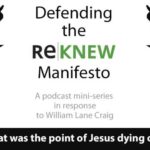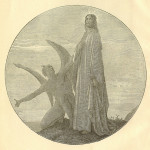We run our website the way we wished the whole internet worked: we provide high quality original content with no ads. We are funded solely by your direct support. Please consider supporting this project.
Atonement, Christus Victor & Aslan

No one illustrates this Christus Victor view of Christ’s work on the cross more beautifully than C.S. Lewis in his famous fantasy, The Lion, The Witch and the Wardrobe. The gist of the story is that four children find their way into another world called Narnia through a magical wardrobe. They quickly learn that an evil and powerful witch has seized control of Narnia and proclaimed herself its Queen. One of the children – a whiney brat named Edmund – ends up conspiring with the Queen against his three siblings, with whom he never got along well. Fortunately, Edmund’s siblings are able to elude the wicked Queen.
While on the run from the Queen, the three siblings encounter Aslan, the magnificent good lion who is the rightful ruler of Narnia. Aslan graciously heads up a successful rescue operation for Edmund, but before long he’s confronted by the evil Queen. She reminds Aslan of “the Magic which the Emperor put into Narnia at the very beginning.” This Magic is the moral order of Narnia, and, in the words of the wicked Queen, it stipulates that “every traitor belongs to me as my lawful prey and that for every treachery I have a right to a kill. And so,” the witch continues, “that human creature is mine. His life is forfeit to me. His blood is my property.”
Aslan cannot refute the Queen’s claims. There is indeed a moral order that hold’s Narnia together, and this “Deep Magic,” as Lewis calls it, cannot simply be waved aside. To break covenant with God, the source of all life, ito forfeit our life. Edmund forfeited his life to the evil Queen when he sinned against his brother and sisters, and this Deep Magic could not be rescinded.
Yet, Aslan loves Edmund, despite his sin, and so he offers himself up as a sacrifice in Edmund’s place. Since the great Lion is obviously a much greater prize than any “human creature,” and since the Queen thinks killing Aslan would allow her finally to rule Narnia unopposed, she accepts the offer.
Later that night Alsan sneaks away to the Queen’s camp, is mocked and tortured by her evil minions, and is finally put to death on “the Stone Table” where the justice of Narnia’s Deep Magic is carried out. But, of course, Aslan does not remain dead. He is resurrected a while later and the Stone Table is split in two.
When Edmund’s two overjoyed sisters inquire how this happened, Aslan explains,
….though the Witch knew the Deep Magic, there is a magic deeper still which she did not know. Her knowledge goes back only to the dawn of time. But if she could have looked a little further back, into the stillness and the darkness before Time dawned, she would have read there a different incantation. She would have known that when a willing victim who had committed no treachery was killed in a traitor’s stead, the Table would crack and Death itself would start working backwards.
Exercising a Magic that is deeper and older than even the Deep Magic of justice — the magic of pure, self-sacrificial love — Aslan overcomes death, breaks the Stone Tablets, destroys the evil Queen’s hold on Edmund, leads his disciples in a victorious battle against her and thus liberates the inhabitants of Narnia from her oppression. In the end, Edmund is transformed and, along with his three siblings, enthroned as the rightful rulers of Narnia.
Lewis’ marvelous tale brilliantly illustrates how and why Jesus’ life, death and resurrection vanquished Satan and the other fallen gods who had seized God’s “Narnia.” It is based on the understanding that, while both self-sacrificial love and the law are good, they are not equally deep forms of magic. Self-sacrificial love is much older and much deeper. It is therefore the one thing that is able to set a treacherous covenant breaker free from the just condemnation of the law.
Category: General
Tags: Atonement, Christus Victor, Chronicles of Narnia
Topics: Atonement and The Cross
Related Reading

What Changed on the Cross? (podcast)
Greg talks the sin economy and if sin actually threatens God. Episode 473 The Interview: http://traffic.libsyn.com/askgregboyd/Episode_CH_0473.mp3

Greg and N.T. Wright at the Missio Alliance Gathering!
The Missio Alliance North American Gathering will be held April 27-29 in Alexandria, Virginia. The theme this year is Awakenings: The Mission of the Spirit as the Life of the Church. Featured speakers this year include Jorge Acevedo, Greg Boyd, Ruth Padilla Deborst, Tammy Dunahoo, Todd Hunter, Dr. Charles A. Montgomery, Jr., Cherith Nordling, Rev. Dr. Howard-John…

Podcast: Defending the Manifesto (7 of 10)
Greg responds to challenges by William Lane Craig from Craig’s podcast “Reasonable Faith.“ Greg discusses atonement and the shortcomings of penal substitution theology. http://traffic.libsyn.com/askgregboyd/Episode_0062.mp3

What is the Atonement? (podcast)
Greg talks atonement. Episode 668 http://traffic.libsyn.com/askgregboyd/Episode_0668.mp3

The Cross and Cosmic Warfare
Since the time of Anselm in the 11th century, Western theology has focused almost all of its attention on the anthropological dimension of the atonement. In the most popular understanding, the chief thing that God was accomplishing on the cross was satisfying God’s perfect justice and thereby atoning for our sins. The work of the…

Forgiveness in the Christus Victor View of the Atonement
Did Jesus need to die on the cross to satisfy God’s wrath in order for us to be forgiven? Greg discusses the role of forgiveness in the Christus Victor view of the Atonement.
